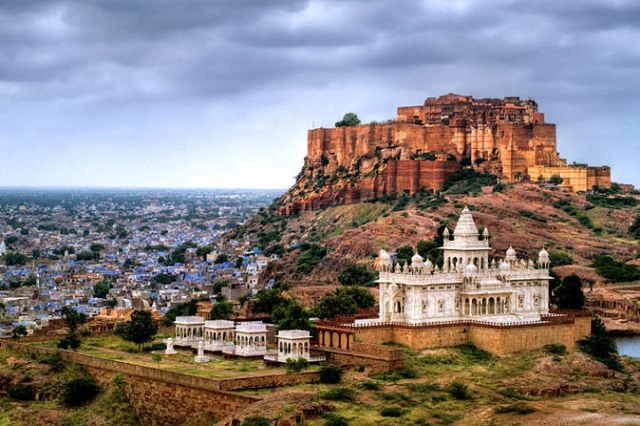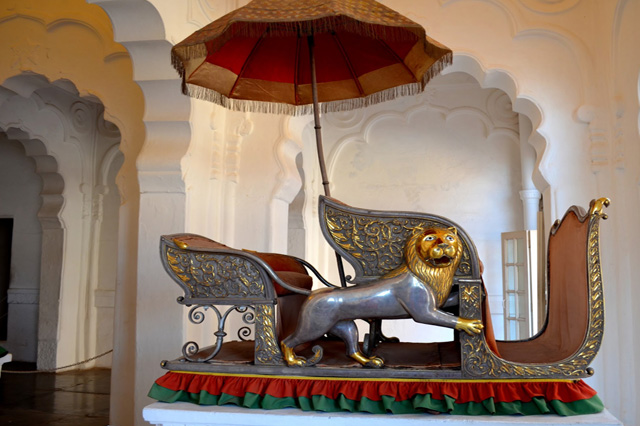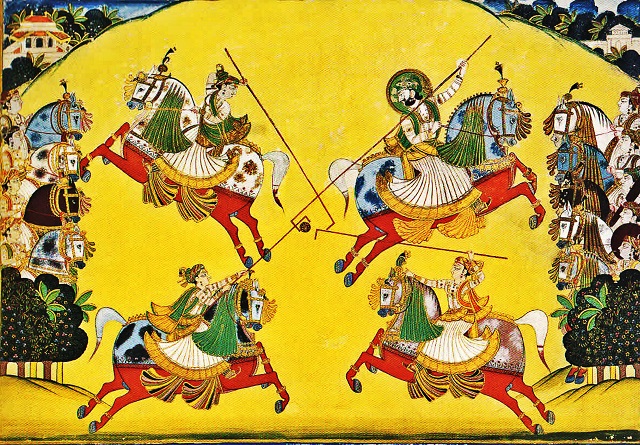Mehrangarh Fort is a fine testimony of India’s splendid past. Rising to a hundred feet, the fort presides over Jodhpur. The red sandstone fort, known as the Citadel of the Sun, is one of the most impressive forts in Rajasthan. Invincible, daunting and yet with a strange haunting beauty, Mehrangarh fort is a gem one must explore.

Mehrangarh fort in Jodhpur – One of the most magnificent forts in India.
History
The history of Mehrangarh Fort is related to Rao Jodha of the Rathore Clan. He ascended as the fifteenth Rathore ruler in 1458. One year after his crowning, the Maharaja was advised to move his capital to a safer place. The 1000-year Mandore fort, the then capital was slowly and gradually deteriorating therefore needed to be abandoned. The search of a new location brought to the isolated hill looming over Jodhpur.
According to legends, the hill on which the mighty fort stands was the home of an ascetic, known as Cheeria Nathji, the lord of birds. The hermit was the sole inhabitant of the hills. On losing his home, he cursed the land. To appease the jinx, a selfless person had to sacrifice his life. This noble act was performed by Raja Ram Meghwal, who finds mention in tales and on stone carving in the fort.
The mighty fort of Mehrangarh fort in Rajasthan, since its erection has never been under seizure. The invincible fortifications still bear cannon marks they had once withstood. Today, this magnificent edifice of Jodhpur is a living testimony that recounts the rich past.
Architecture
Mehrangarh fort is a magnificent edifice of 68-ft wide and 117-ft elevated walls.
There are seven gates of entry to the fort. The most famous among them is the Jaya Pol meaning victory, constructed by Maharaja Man Singh to celebrate his success over the armies of Jaipur and Bikaner. Fatteh Pol, which also means victory gate, was raised by Maharaja Ajit Singh to celebrate the defeat of the Mughals. Dedh Kamgra Pol, still bear the mutilations of cannonballs. Loha Pol, another gate to the fort have the handprints (sati marks) of the ranis who immolated themselves on the funeral pyre of their husband, Maharaja Man Singh.
Impressive cenotaphs dot the fort which testify the valor of the Rathore kings of Jodhpur. The chhatri of Kirat Singh Soda, the honorable soldier who died guarding the fort against the Amber armies is a wonderful specimen.
The brilliant craftsmanship is exhibited by the fascinating sandstone palaces within the Fort. Explore the grand palaces like the Moti Mahal or the Pearl Palace, where you can marvel at the royal throne of Jodhpur known as the Sringar Chowki. The Phool Mahal has a beautiful ceiling adorned by gold filigree work. The Umaid Villas showcase beautiful Rajput miniature paintings while the Ajit Villas displays the musical instruments and the royal attires. The Rang Mahal, Chandan Mahal and Maan Vilas are exquisite splendors.
The fort also encloses the Mehrangarh Fort Museum. It has all exhibits of the olden days, like the royal palanquins, miniature paintings, furniture, and historic armory etc.
Galleries in Mehrangarh Fort Museum
Elephant’s howdahs
Do not miss a visit to this gallery. The exhibits include Howdahs, a kind of two-compartment wooden seat which were fastened onto the elephant’s back. Mostly covered with gold and silver embossed sheets, the front compartment, with more leg space and a raised protective metal sheet, was meant for kings or royalty, while the rear smaller one was for a reliable bodyguard disguised as a fly-whisk attendant.

Palanquins
Palanquins (palkis/dolis) were the popular means of travel for the ladies of the nobility. Marvel at the exquisite designs.
Daulat Khana – Treasures of Mehrangarh Museum
This gallery displays a collection of fine and applied arts of the Mughal period of Indian history. The exhibits here date to the period during which the Rathore rulers of Jodhpur maintained close links with the Mughal emperors. Here you can also visit the remains of Emperor Akbar.

Daulat Khana – Treasures of Mehrangarh Museum
Armory
For a rare collection of armor from every period in Jodhpur, this gallery is something you should not miss. Marvel at sword hilts in jade, silver, rhino horn, ivory, shields studded with rubies, emeralds and pearls and guns with gold and silver work on the barrels. There are also a display of the personal swords of many emperors. Among them, the outstanding historical piece like the Khaanda of Rao Jodha, weighing over 3 kg, the sword of Akbar the Great and the sword of Timur are the ones you must check out.
Paintings
This Gallery displays colors of Marwar-Jodhpur and the finest example of Marwar paintings.

The Turban Gallery
This gallery preserves and display the many different types of turbans once widespread in Rajasthan. Every community, region and festival had its own head-gear and you can find it all here.
Tourist attractions in Mehrangarh
National Geological Monument
The Mehrangarh Fort is a titled National Geological Monument by the Geological Survey of India. It is a part of the Malani Igenus Suite seen in the Thar Desert region. Representing the last segment of igneous activity of Precambrian age in the Indian Subcontinent, this geological feature is something you must have a look at.
Rao Jodha Desert Rock Park
Spread over 72 hectares, adjoining Mehrangarh Fort lies the Rao Jodha Desert Rock Park. The rare ecologically restored desert park was created in 2006 and opened to the public in February 2011. The park contains unique volcanic rock formations such as rhyolite, welded tuff, and breccia, sandstone formations. Visit the tourist centre with interpretation gallery, and a native plant nursery, for better understanding.
Chamunda Devi Temple
The Chamunda Devi Temple houses Chamunda Mataji, Rao Jodha’s favorite goddess. The Royal Family’s revered goddess temple is a beautiful site to visit, especially during the Dussehra celebrations.



